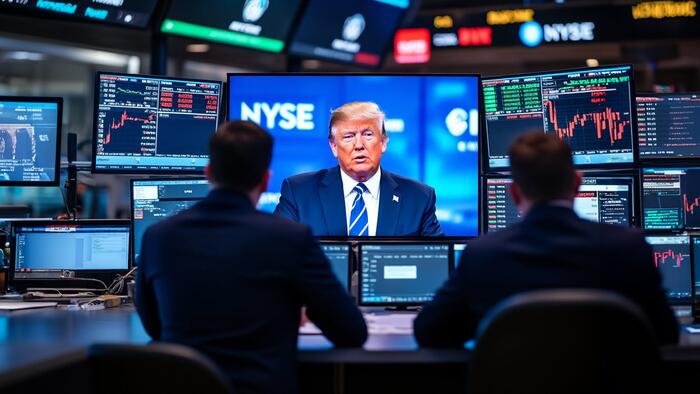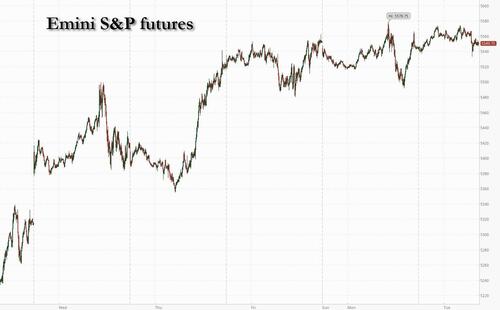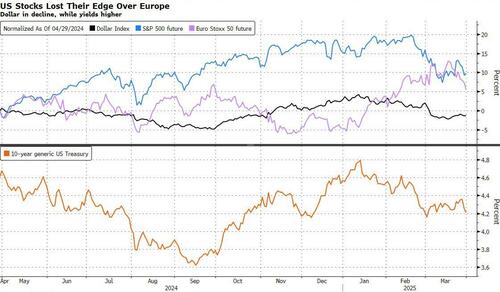


US equity futures were unchanged, erasing a modest gain and loss earlier, after General Motors pulled earnings guidance for 2025 and put share buybacks on hold until it has more clarity on the impact of US tariffs. As of 8:15am, S&P futures were flat, while Nasdaq futures were down 0.2% as TSLA rose +1.0% pre-mkt, followed by MSFT +0.5% and AMZN +0.5%. GM dropped in premarket trading, reversing an earlier gain, as it said it would suspend $4 billion of share repurchases. Bond yields and USD are higher (2-, 5-, 10-yr yields are 1.6bp, 2.9bp, 2.7bp higher). Commodities are mixed with WTI futures dropping 1.7%, adding to sharp losses seen Monday, Base Metals higher, and Precious Metals mixed. WSJ repeated a report from last week that Trump may ease his auto tariffs today; Elsewhere, Scott Bessent set July 4 as the goal to pass Trump’s tax cut package; he will announce the debt-ceiling X-date this week or next. Today, the key macro focus will be JOLTS Job Openings and Conf. Board Consumer Confidence.
In premarket trading, Magnificent Seven stocks are mixed as futures whipsaw )Amazon +0.2%, Alphabet +0.2%, Microsoft +0.1%, Apple +0.1%, Tesla -0.1%, Meta -0.1%, Nvidia -0.7%). General Motors (GM) shares fall 2.4% premarket after the automaker withdrew 2025 earnings guidance and paused $4 billion in share repurchases until it has more clarity on tariff impacts. Hims & Hers Health Inc. (HIMS) shares soared as much as 46% as it’s among companies Novo Nordisk A/S is partnering with to offer its popular weight-loss drug Wegovy to more US patients at a reduced price. Here are some other notable premarket movers:
As Bloomberg notes, after weeks of intense volatility, markets now seem to be in a holding pattern. Gold is consolidating after hitting record highs, the DXY dollar index remains below its key 100 level, and oil is drifting lower. For investors, it’s difficult to find consensus, with risk management, confidence, and the guiding narrative on US exceptionalism upended by tariffs.
“With the uncertainty created by the tariffs we need to start pricing at least a probability of a US recession,” Johanna Kyrklund, chief investment officer at Schroders Plc, told Bloomberg TV. “As we analyze each company stock-by-stock, we’re looking for that risk to growth.”
Tariff sentiment continues to drive price action, with investors weighing plans by the Trump administration to ease the impact of auto tariffs by lifting some levies on foreign parts for cars and trucks made inside the US. However, it doesn’t look like a trade resolution is coming anytime soon. China’s top diplomat warned countries against caving in to US tariff threats, and Trump’s tactics are only serving to make China’s Xi Jinping more popular. At home, Treasury Secretary Bessent set a July 4 goal to pass a multi-trillion dollar tax cut package to appease voters getting fed up of Trump’s handling of the economy.
Still, with just over a third of S&P 500 companies reporting quarterly results, of those, 75% have beat estimates, according to data compiled by Bloomberg. S&P 500-listed companies worth $20 trillion are set to deliver results this week in one of the heaviest for 2025 earnings seasons. But the next few days are key: companies worth $20 trillion are set to deliver results this week in one of the heaviest for 2025 earnings seasons.
Beyond the plethora of earnings, investors will be tracking data for clues on economic resilience in the face of tariffs. Prospects for Federal Reserve interest-rate cuts will be guided by Friday’s US non-farm payrolls figures. Sentiment earlier was boosted by signs of easing trade tensions after a White House official said imported automobiles would be given a reprieve from separate tariffs on aluminum and steel.
In Canada, the Liberal Party is projected to win a fourth consecutive election, giving a mandate to former central banker Mark Carney.
European stocks rise 0.4%, with risk sentiment improving after the US said imported autos would be given a reprieve from separate tariffs on aluminum and steel. Miners, travel and banks are the strongest-performing European sectors, while the IBEX lags peers, dropping 0.5%, as Spain deals with the fallout of a massive blackout. In earnings, Deutsche Bank shares rise after its trading unit hit a record. HSBC climbs after announcing a fresh share buyback. BP shares fall after the oil major cut its buyback as profit missed forecasts. Here are some of the biggest movers on Tuesday:
Asian equities advanced, rising to the highest level this month, on a rally in some Chinese technology shares and a sentiment boost from further signs of the US dialing down its trade rhetoric. The MSCI Asia Pacific Index gained as much as 0.7% Tuesday. TSMC and Meituan provided the biggest boost to the gauge, while India’s Reliance Industries extended its rally triggered by better-than-expected earnings. Benchmarks advanced in Hong Kong, Taiwan, India and South Korea. Japanese markets were closed for a holiday. Asian markets have largely recovered from the hit sparked by President Donald Trump’s reciprocal tariff announcements on April 2 amid hopes for trade deals. In the latest positive sign, Trump is on track to ease the impact of his auto tariffs, with changes sought by the industry that would lift some levies on foreign parts made inside the US.
In FX, the Bloomberg Dollar Spot Index rose 0.2% after falling 0.5% on Monday, when a disappointing manufacturing activity report added to concerns over US economic growth; haven currencies the yen and Swiss franc, were the biggest underperformers versus the dollar, down 0.6% and 0.4% respectively
In rates, treasury futures drift lower into early US session, unwinding a portion of gains seen Monday and underperforming core European bonds. US yields cheaper by 1bp to 3bp across the curve with 2s10s steeper by 1bp on the day; US 10-year yields trade back up 3bps to around 4.24% with bunds and gilts outperforming by 4bp and 5.5bp in the sector.
In commodities, WTI drifts 1.6% lower to trade near $61.03. Spot gold falls roughly $29 to trade near $3,315/oz. Most base metals are in the green. Bitcoin climbs to around $95,000.
The US economic calendar includes March wholesale inventories, February S&P CoreLogic house prices (9am), March JOLTS job openings, April consumer confidence (10am) and April Dallas Fed services activity (10:30am). From central banks, we’ll hear from the ECB’s Cipollone and Holzmann, and the BoE’s Ramsden. The Fed's talking heads remain mute thanks to the communications blackout ahead of the May 7 FOMC meeting. Finally, earnings releases include Starbucks, Visa, Pfizer and UPS.
Market Snapshot
Top Overnight News
Tariffs/Trade
A more detailed look at global markets courtesy of Newsquawk
APAC stocks were mostly in the green but with some of the gains capped following the choppy performance stateside and in holiday-thinned conditions with Japanese markets closed for a holiday, while reports that US President Trump is expected to soften the impact of his automotive tariffs saw a muted reaction. ASX 200 gained amid outperformance in the energy, tech and resources sectors, while miners were also lifted as participants digested output updates. Hang Seng and Shanghai Comp were varied as the mainland lagged owing to uncertainty from the US-China trade war with US Treasury Secretary Bessent recently commenting that it is up to China to de-escalate and that he has an "escalation ladder in his back pocket", while China's Foreign Ministry reiterated its denial regarding a Trump-Xi call and Foreign Minister Wang Yi warned that compromise and backing down would only embolden the bully.
Top Asian News
European bourses opened modestly firmer/flat, but some modest pressure crept into the complex as the morning progressed – with indices generally off best levels, to show a mixed picture in Europe. European sectors hold a slight positive bias, albeit with the breadth of the market fairly narrow. Basic Resources takes the top spot, followed closely by Media and Banks. Energy is found at the foot of the pile, dragged down by post-earning losses in BP (-4%); the continued pressure in the crude complex is also not helping. Autos find themselves towards the middle of the bunch. For the sector more generally, US President Trump is expected to soften the impact of his automotive tariffs, by preventing duties on foreign-made cars from stacking on top of other tariffs he imposed and easing some levies on foreign parts used to manufacture cars in the US, via WSJ. For stock specifics, Porsche AG (-5%) dips after it cut FY25 guidance; Volvo Car (-8.3%) reported a significant miss on its EBIT and Revenue figure and launched a SEK 18bln cost and cash action plan.
Top European News
FX
Fixed Income
Commodities
Geopolitics: Middle East
Geopolitics: Ukraine
US Event Calendar
DB's Jim Reid concludes the overnight wrap
It's shorts and sandals weather here in the UK which is lovely unless it forces you to look at the horrible brusing of my broken little toe. Enjoy the sunshine if you're in Europe this week.
After last week’s rally, markets saw a choppy start to a busy week with the S&P 500 recovering from a -1% decline to narrowly post a fifth consecutive gain (+0.06%) last night, even as the Mag-7 (-0.36%) lagged ahead of Meta and Microsoft earnings tomorrow and Apple and Amazon on Thursday. 10yr Treasuries (-2.7bps) also gained for a fifth session in a row, falling to their lowest level in three weeks at 4.21%.
On tariffs, the latest newsflow was actually fairly positive at face value, as US officials continued to sound optimistic about potential trade deals yesterday. For instance, Treasury Secretary Bessent said that they’d had “many countries come forward and present some very good proposals”. He also said “I would guess that India would be one of the first trade deals we would sign”. Separately, White House Press Secretary Karoline Leavitt also said that more details on trade talks would be announced this week. And later on, Bessent tweeted that they were “continuing to make substantive movement on negotiations with many of our trading partners.” So the rhetoric from the administration is still pointing towards negotiations, rather than further escalation. However, there was still little sign of dialogue between the US and China, with Bessent saying “I believe it’s up to China to de-escalate”. Overnight the incremental positive news has continued with the White House confirming an earlier WSJ story that imported autos would not also face additional aluminum and steel tariffs. This has helped lift S&P (+0.19%) and Nasdaq (+0.24%) futures this morning.
This steady flow of mostly more positive trade headlines lifted the S&P 500 from as low as -1.02% mid-way through yesterday's session to ultimately close marginally higher on the day (+0.06%). That left the index still narrowly in technical correction territory, closing -10.02% below its peak in mid-February, but its slightly above that mark again this morning. It was actually a decent day in terms of market breadth, with two-thirds of the S&P 500 constituents moving higher on the day and its equal-weighted version up +0.30%. By contrast, tech stock underperformance saw the Magnificent 7 decline by -0.36%, led by a -2.05% fall for Nvidia as the chipmaker struggled following news that China’s Huawei is set to test a new chip that could end up being a competitor.
Earlier in yesterday’s session, the mood at the lows wasn’t helped by the Dallas Fed’s manufacturing survey, which plunged to its lowest level since May 2020. Specifically, the general business activity index was down to -35.8, and the raw materials prices index also moved up to its highest level since mid-2022, at 48.4. So that added to the stagflationary narrative, although it’s worth noting that this is a survey once again rather than hard data, and so far the surveys have tended to suggest a worse performance relative to the hard data. As a result, markets weren’t too reactive to the print directly, but it added to the more downbeat backdrop going into this week’s other releases.
US Treasuries saw a more consistent performance, with 10yr yields falling -2.7bps to 4.21% and 2yr yields down -5.4bps to 3.70%, their lowest level since April 4th. Yesterday afternoon, the Treasury released its latest quarterly borrowing estimates, with the Q2 issuance estimate revised up to $514bn from $123bn due to a lower starting cash balance and with the Q3 estimate at $554bn. These figures were slightly above our rate strategists expectations but this may be due to the Treasury not yet factoring in increased tariff revenues. The announcement had limited impact on yields, which closed near the session’s lows. In other fiscal news, after the US close Treasury Secretary Bessent said the administration hoped to have Congress pass their tax bill by July 4.
With rates moving lower, one US asset that did lose ground yesterday was the dollar, with the dollar index down -0.54%, as the safe haven currencies of the Swiss franc (+1.02%) and Japanese yen (+1.17%) outperformed.
Back in Europe, there was a stronger risk-on tone, which reinstated the pattern of European outperformance in 2025. In fact, at the intraday peak, the DAX (+0.13% at the close) even managed to entirely erase its losses since Liberation Day, although by the end of the session it was still -0.53% beneath its levels on April 2. Nevertheless, the index was still up for the 8th time in the last 9 sessions, and those gains were echoed across the continent. For instance, the STOXX 600 (+0.53%) advanced for a 5th consecutive day, as did France’s CAC 40 (+0.50%). The smallest yet most notable rise was the FTSE 100 (+0.02%), which posted an 11th consecutive advance for the first time since 2019, and if it manages a 12th consecutive gain today, that would be the first time since 2017.
Consistent with that risk-on tone, European sovereign bond yields also moved higher, with those on 10yr bunds (+5.1bps), OATs (+4.9bps) and BTPs (+5.5bps) all rising. Likewise, credit spreads tightened further, with Euro HY spreads down -4bps to 349bps, edging closer to their Liberation Day level of 322bps.
In political news, Prime Minister Mark Carney's Liberal Party is projected to win the Canadian federal election. However, with projections showing the Liberals leading in only 155 of 343 seats – shy of the 172 needed for a majority – Carney is likely facing a minority government and will need to negotiate with other parties to pass legislation. The Conservatives are currently projected to win 150 seats. So a remarkable comeback for the Liberals relative to their January lows when they were over 25pp down in the polls but seemingly not quite as good as they would have hoped as the polls closed last night.
In Asia the fresh overnight news on auto tariffs we discussed at the top seems to be helping push markets higher. The S&P/ASX 200 (+0.91%) has hit a near 2-month high with the KOSPI (+0.65%) and the Hang Seng (+0.38%) also edging higher while Chinese equities are bucking the positive trend with the CSI (-0.14%) and the Shanghai Composite (-0.05%) seeing minor losses. Elsewhere, Japanese markets are closed for a public holiday. There’s no trading of cash Treasuries in Asia as Japan is closed.
To the day ahead now, and data releases from the US include the JOLTS report for March, the Conference Board’s consumer confidence indicator for April, and the FHFA’s house price index for February. Meanwhile in the Euro Area, we’ll get the M3 money supply for March, and the European Commission’s economic sentiment indicator for April. From central banks, we’ll hear from the ECB’s Cipollone and Holzmann, and the BoE’s Ramsden. Finally, earnings releases include Starbucks, Visa, Pfizer and UPS.


